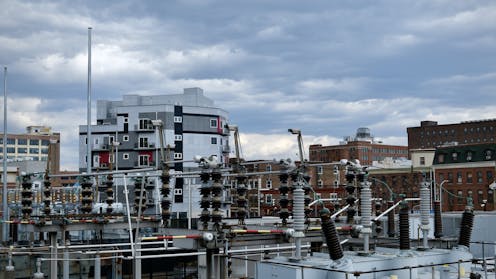Why your electricity bill is so high and what Pennsylvania is doing about it
- Written by Hannah Wiseman, Professor of Law, Penn State

Americans’ electricity bills tend to tick up each year in line with inflation[1].
But upgrades to electric wires[2], reinforcing and protecting power lines[3] from severe weather[4], and changing fuel costs – among other factors – are sending rates soaring.
High electricity consumption from data centers and other sources of rising demand will likely cause further increases[5] in the near future.
The impact on consumers is particularly dramatic[6] in Pennsylvania, where rate hikes are widespread.
For example, the monthly bill for a PECO residential customer who uses 700 kilowatt hours of electricity monthly increased 10%[7] – or US$13.58 – in 2025. These bills will go up another $2.70 each month[8] in 2026.
Retail price adjustments approved by the Pennsylvania Public Utility Commission for most electric distribution utilities effective December 2024[9] led to higher bills for many customers across the state. In some parts of Pennsylvania, the estimated increases topped an estimated 30%[10].
As professors who work in the areas of energy law[11] and electricity markets[12], we know electricity costs are rising in many parts of the U.S[13].
But Pennsylvania faces distinct challenges related to its electric grid – the maze of wires and generators – that drive both the growing demand[14] for electricity and the limited supply[15].
PJM and the electric grid
Pennsylvania power plants produce a lot of electricity. In fact, the Keystone State is the the largest exporter of electricity[16] in the U.S. and has been for many years.
But the electricity Pennsylvania produces doesn’t always stay in state.
That’s because Pennsylvania’s electric grid is managed by a company called PJM[17]. PJM coordinates the flow of electricity through all or parts of 13 states and the District of Columbia[18], and it ensures the wholesale electricity transmission system operates reliably and safely.
Pennsylvania electric utilities, such as PECO or Duquesne Light, then distribute this wholesale electricity to retail customers, including homeowners and renters.
PJM requires the utilities to ensure ahead of time that they can meet their customers’ future electricity demands, including during heat waves and winter storms[19]. This requirement is met using a market called a “capacity auction[20],” in which electricity suppliers bid to provide physical infrastructure that will generate electricity in the future.
The prices at the 2025-2026 PJM capacity auction were more than 800% higher[21] than the previous year, in part due to the growing demand for electricity within PJM. This amounts to tens of billions of dollars in extra costs.
Power plants in Pennsylvania can’t simply stop exporting electricity and supply more in-state power because they dispatch their power into the regional grid operated by PJM, and the flow of electricity is dictated by the physical structure of this grid.
Soaring demand from data centers
U.S. electricity demand rose 3% in 2024[23] and is expected to rise even more rapidly[24] in the coming years.
Much of this new demand comes from data centers, which support everything from AI applications and data storage – think of the thousands of emails and files backed up on our computers – to sports betting, online retailers such as Amazon, and national security applications such as the North American Aerospace Defense Command[25].
Pennsylvania is on the same electric grid as Virginia, which hosts about a quarter of all data center capacity[26] in the Americas. New data centers are also being built in Pennsylvania[27].
Rising demand[28] is also driven by the increase in electric vehicles[29] and the replacement of gas- and oil-based furnaces with electric heat pumps[30]. These replacements are ultimately more energy efficient but require electricity.
Bottlenecks in supply
The increase in electricity demand within PJM is happening at the same time that supply is shrinking.
Many old generating plants in the PJM grid are retiring[31] as they near the end of their useful lives and become less profitable for plant operators, particularly as natural gas and solar become more affordable. Some of these older power plants also emit a lot of pollution and are costly to retrofit to meet current pollution limits[32].
Beyond the challenge of plant retirements, PJM has been slow to allow hundreds of new proposed power plants[33] – most of them solar- and battery-based – to connect to transmission lines.
This long “interconnection queue[34]” prevents new, needed generation from coming online. This is happening even though companies are eager and ready to build more generation and battery storage.
Aging infrastructure and growing weather extremes
One of the primary recent drivers[35] of high consumer electric bills is that the utilities have been slow to upgrade their aging wires.
Many have recently made major investments in new infrastructure[36] and in some cases are burying or strengthening wires[37] to protect them from increasingly extreme weather[38].
Electricity customers are footing the bill[39] for this work.
Response from policymakers
In response to rising electricity prices, Pennsylvania Gov. Josh Shapiro filed a legal complaint[41] with the Federal Energy Regulatory Commission against PJM in December 2024. This complaint blamed PJM’s capacity auction design for creating unnecessary costs for consumers.
According to the settlement reached after the complaint, PJM’s price caps will be 35% lower[42] at the next major capacity auction. This reduction in wholesale prices could limit retail price increases.
But this is at best a temporary fix. It doesn’t address the increasing demand, aging power infrastructure battered by extreme weather, or transmission bottleneck.
In order for Pennsylvania residents to see lower electric bills anytime soon, more changes are needed. For example, many experts[43] previously observed[44] that PJM needs to fix the queue[45] and get online the many power plants[46] that are ready to build and just waiting for a transmission interconnection.
While PJM has reformed its queue process, the queue is still long. New power plants are not going up fast enough, in part due to additional challenges[47] such as local opposition and supply chain and financing issues.
Read more of our stories about Philadelphia and Pennsylvania[48].
References
- ^ in line with inflation (www.eia.gov)
- ^ upgrades to electric wires (eta-publications.lbl.gov)
- ^ reinforcing and protecting power lines (www.feretirees.com)
- ^ severe weather (www.gao.gov)
- ^ further increases (jlarc.virginia.gov)
- ^ particularly dramatic (www.eia.gov)
- ^ increased 10% (www.puc.pa.gov)
- ^ $2.70 each month (www.puc.pa.gov)
- ^ effective December 2024 (www.puc.pa.gov)
- ^ topped an estimated 30% (www.puc.pa.gov)
- ^ energy law (pennstatelaw.psu.edu)
- ^ electricity markets (scholar.google.ca)
- ^ in many parts of the U.S (www.newsweek.com)
- ^ growing demand (insidelines.pjm.com)
- ^ limited supply (insidelines.pjm.com)
- ^ the largest exporter of electricity (www.eia.gov)
- ^ PJM (www.pjm.com)
- ^ 13 states and the District of Columbia (www.pjm.com)
- ^ during heat waves and winter storms (theconversation.com)
- ^ capacity auction (learn.pjm.com)
- ^ more than 800% higher (www.reuters.com)
- ^ Nathan Howard via Getty Images (www.gettyimages.com)
- ^ rose 3% in 2024 (gridstrategiesllc.com)
- ^ expected to rise even more rapidly (www.pjm.com)
- ^ North American Aerospace Defense Command (www.norad.mil)
- ^ a quarter of all data center capacity (jlarc.virginia.gov)
- ^ being built in Pennsylvania (files.dep.state.pa.us)
- ^ Rising demand (www.pjm.com)
- ^ increase in electric vehicles (www.pjm.com)
- ^ electric heat pumps (www.pjm.com)
- ^ are retiring (insidelines.pjm.com)
- ^ pollution limits (whyy.org)
- ^ new proposed power plants (www.utilitydive.com)
- ^ interconnection queue (pv-magazine-usa.com)
- ^ primary recent drivers (emp.lbl.gov)
- ^ major investments in new infrastructure (www.eia.gov)
- ^ burying or strengthening wires (www.lehighvalleynews.com)
- ^ increasingly extreme weather (www.ncei.noaa.gov)
- ^ footing the bill (emp.lbl.gov)
- ^ David Espejo/Moment Collection via Getty Images (www.gettyimages.com)
- ^ legal complaint (www.pa.gov)
- ^ price caps will be 35% lower (www.pa.gov)
- ^ experts (www.synapse-energy.com)
- ^ previously observed (www.ferc.gov)
- ^ fix the queue (www.utilitydive.com)
- ^ many power plants (www.monitoringanalytics.com)
- ^ additional challenges (www.utilitydive.com)
- ^ Philadelphia and Pennsylvania (theconversation.com)
Authors: Hannah Wiseman, Professor of Law, Penn State



